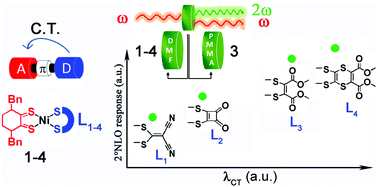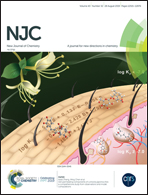Design of nickel donor–acceptor dithiolenes for 2nd order nonlinear optics: an experimental and computational study†
Abstract
The structures and properties, including second-order non-linear optical properties in solution and in polymethylmethacrylate (PMMA) films, of new nickel heteroleptic donor–acceptor dithiolene complexes are reported here ([Ni(Bn2pipdt)L1–4], 1–4). The acceptor dithione system (Bn2pipdt = 1,4-dibenzylpiperazine-2,3-dithione) is invariant, whereas the donor dithiolate moiety varies in 1 to 4 (i-mnt = 2,2-dicyanoethylene-1,1-dithiolate) (L1), sqdt = 1,2-dithiosquarate (L2), ddmedt = 1,2-dicarbomethoxyethylene dithiolate (L3), and dddmedt = 5,6-bis(methoxycarbonyl)-1,4-dithiine-2,3-bis(thiolate) (L4). Molecular structural characterization of 1, 3 and 4 points out that the metal center exhibits a square-planar geometry bound by the dithione ligand Bz2pipdt, and by three different dithiolate-type ligands. Complexes 1–4 are characterized in the visible region by a peak of moderately strong intensity, which undergoes negative solvatochromism. The molecular quadratic optical nonlinearities were determined in DMF solution by the electric field induced second harmonic generation technique, working with a 1907 nm incident wavelength. The μβ1907 values (−680 (1), −855 (2), −1080 (3); and −1180 (4)) (10−48 esu) were measured, showing that 1–4 exhibit negative second-order polarizabilities whose values depend on the donor ligand. While 1–4 exhibit similar thermolytic behavior, when embedded in a PMMA poled matrix, only 3 maintains second-order NLO properties in the solid state. A good NLO response with a value of the three nonzero coefficients of the second-order susceptibility tensor χ(2)33, χ(2)31, and χ(2)15 = 2.20 ± 0.44 pm V−1, 0.56 ± 0.12 pm V−1 and 0.42 ± 0.08 pm V−1, respectively, was found. According to computational studies, the μβ1907 sequence is mainly related to the donor capability of the dithiolate ligands, which affects the HOMO–LUMO energy gap (2.05 (1), 1.80 (2), 1.56 (3), and 1.36 (4) eV), and it can thus modulate the position of the low-energy absorption and related properties in the series.



 Please wait while we load your content...
Please wait while we load your content...